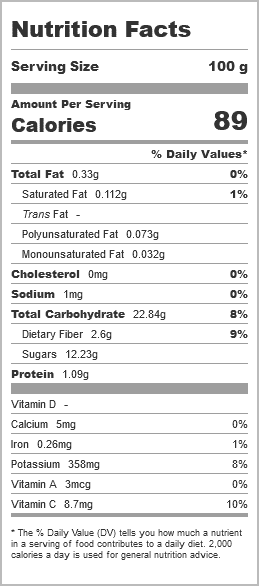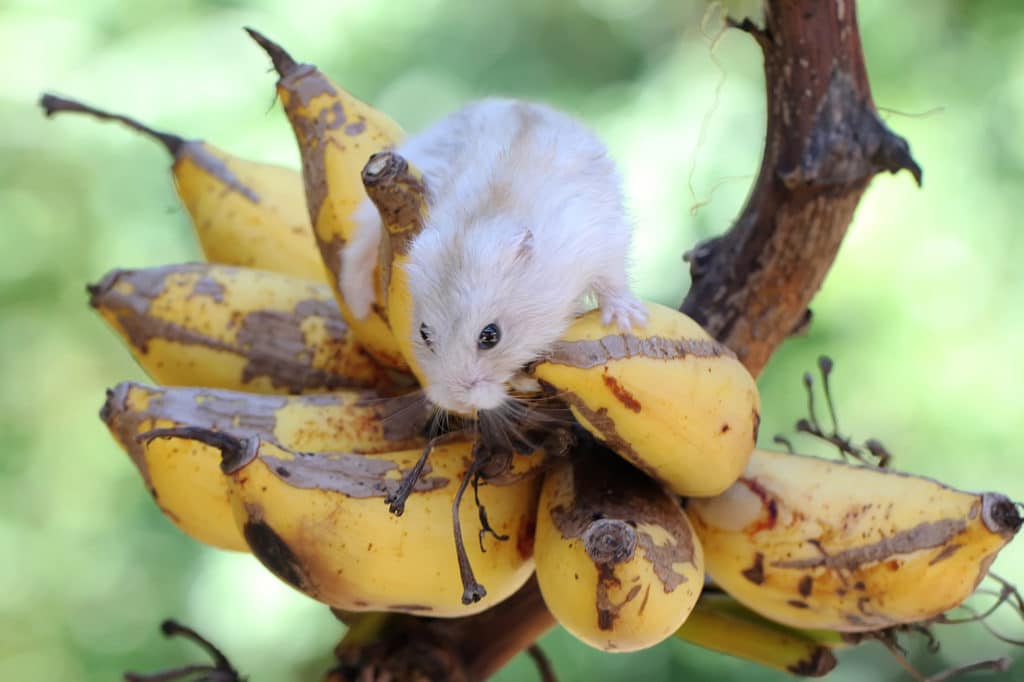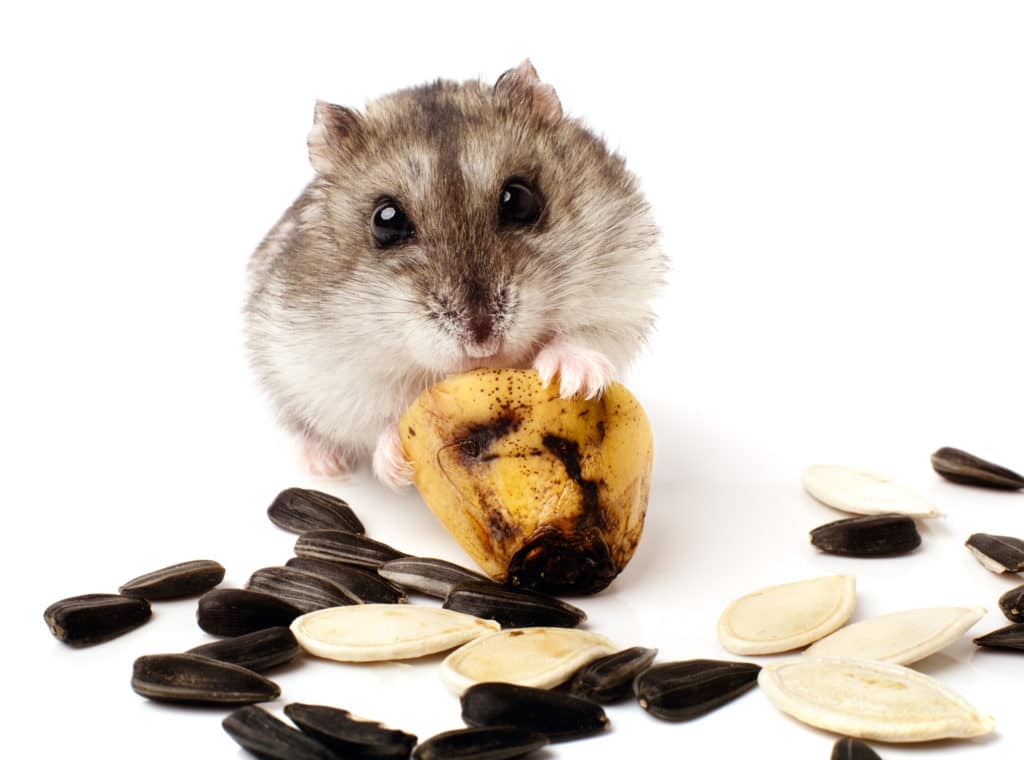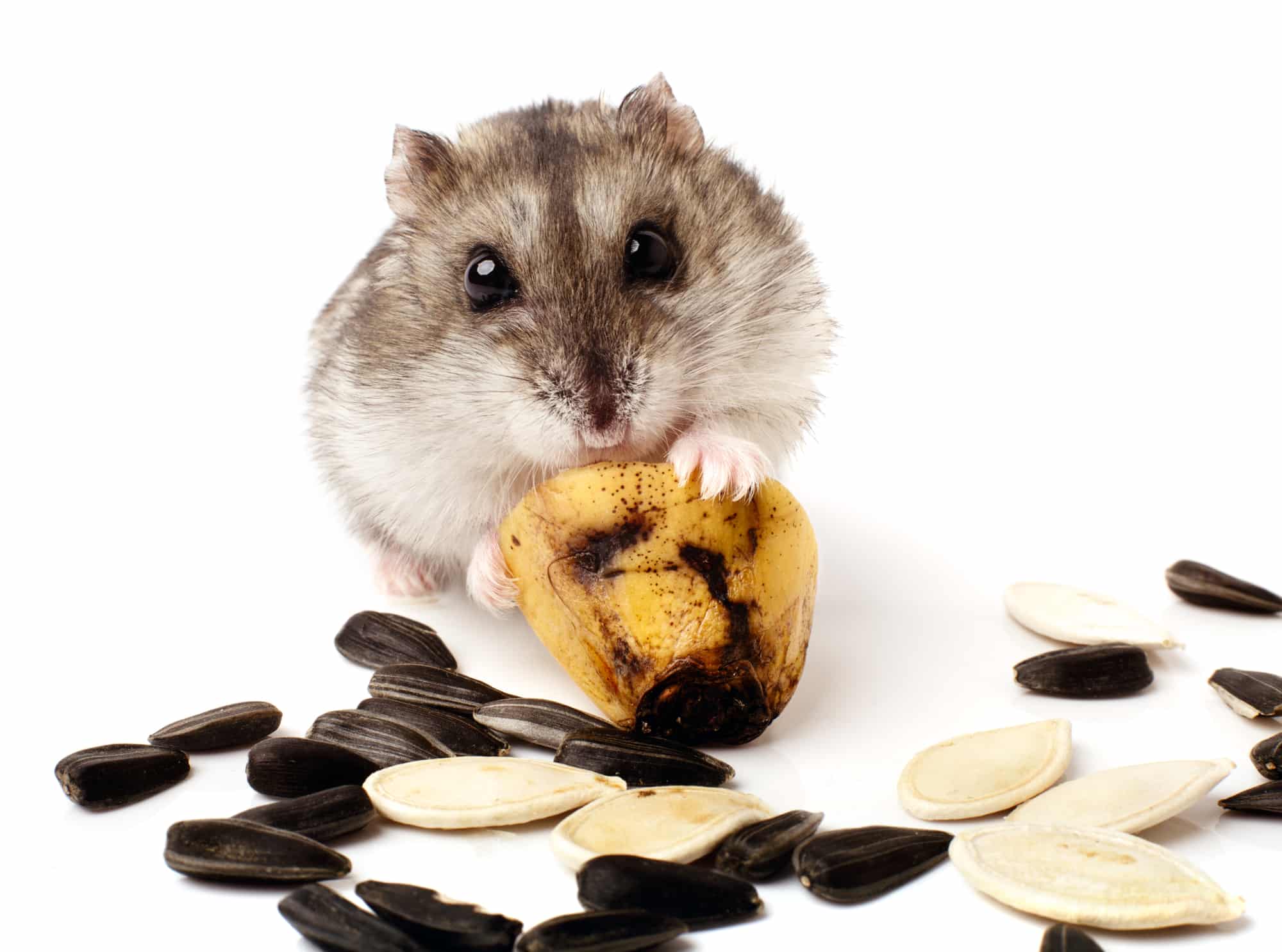Banana is a popular fruit that is eaten in almost every single country in the world. But it is not surprising considering how cheap it is. It is also healthy, nutritious, and tasty. That’s why people of all ages love it. But can hamsters eat bananas? Are bananas healthy for our furry friends? What is the amount of banana that a hamster can eat? Find answers to all these questions in this blog post.
Banana – Nutrition Data
What nutrients does 100g of bananas contain, and how much? Let’s find out.

(Source: Fat Secret)
What can happen if hamsters eat bananas?
Before we find out if hamsters can eat bananas, let’s first figure out the health benefits and risks of feeding bananas to hamsters.

Health benefits of bananas
1. Banana contains soluble fiber. This type of dietary fiber dissolves in water to form a gel that can improve digestion. Unripe bananas also contain resistant starch. Resistant starch possesses the qualities of soluble fiber as well as insoluble fiber. Just like insoluble fiber, it shows resistance to digestion by passing through the digestive system undigested until it reaches the colon (Source: Clean Eating Mag). But once it reaches the colon, it acts like soluble fiber and is fermented by the good bacteria there. This process creates more good bacteria that can prevent constipation and reduce cholesterol levels (Source: WebMD).
2. Pectin, a type of soluble fiber found in both ripe and unripe bananas, softens stools, reduces constipation, and may even help prevent colon cancer (Source: Healthline).
3. There is no research to support the idea that bananas aid in weight loss. But a correlation between higher fiber intake and lower body weights has been found (Source: MDPI). So, since bananas contain fiber, they may aid in weight loss. Fiber can create the feeling of fullness sooner while slowing down the emptying of the stomach. This can help lower blood sugar levels and the risk of diabetes. Fiber may also aid in reducing cholesterol levels and reducing the risk of heart disease (Source: Medical News Today).
4. Bananas are a rich source of potassium. Potassium can help counter the dangerous effect of sodium on the body, thereby reducing blood pressure and the risk of heart disease and stroke. It can also keep your kidneys healthy and reduce the risk of kidney stones. Bananas also contain magnesium. Magnesium helps the nervous system function properly while regulating the sugar and cholesterol levels in the body.
5. Bananas are a great source of energy. According to a study, eating bananas before and after endurance workouts can improve performance (Source: PubMed). Moreover, eating bananas can increase the dopamine levels in the body. Dopamine is a chemical behind the feelings of motivation and reward.
6. Bananas contain antioxidants like flavonoids and amines that protect the body from the oxidative damage caused by free radicals. Free radicals are harmful molecules produced not only by smoking and excessive drinking but also during biological processes like respiration. They can cause chronic diseases like cancer.
7. Bananas are also a rich source of Vitamin C. Vitamin C is needed for the body tissues to grow, develop, and repair themselves. Vitamin C helps the immune system work properly, heals wounds, and helps the bones, teeth and cartilage stay strong. Bananas are also high in Vitamin B6. The body needs Vitamin B6 to create antibodies that help fight infections. This vitamin is also needed for the nerves to function properly. It also helps regulate blood sugar levels and create red blood cells. It helps metabolize proteins. So, if the diet contains a lot of protein, the body will need more Vitamin B6 (Source: Healthy Eating).
Risks
1. Bananas are a rich source of fiber. But unfortunately, they contain a lot of sugars too. So, eating too many bananas can lead to weight gain.
2. Glycemic Index (GI) is a value that tells how likely a food item is to raise blood sugar levels. Food items that have a GI of less than 55 are classified as low GI foods. Green Banana has a GI of 30, an unripe yellow banana has a GI of 41, and a ripe yellow banana has a GI of 50 – 60. So, when eaten in excess, bananas, especially the yellow ripe ones, can increase blood sugar levels and cause diabetes.
3. Bananas contain a lot of potassium. So, eating them in excess can cause hyperkalemia, which can impact the functioning of muscle and nerve cells in the body.
4. Since banana is a sugary food, it can cause tooth decay.
5. Banana contains tannic acid, which, when consumed in excess, can cause some serious constipation (Source: Eat This Not That).
Different types of hamsters vs. banana
Until now, we looked at the advantages and disadvantages of eating bananas. In this section, let’s find out if your hamster can eat bananas. But you’ve to understand that there is no universal answer to the question “Can hamsters eat bananas?” because there are different species of hamsters that differ significantly in size. So, we have to look at each individual species of pet hamster and find out if they can eat bananas. So, let’s continue.
Can Campbell dwarf hamsters eat bananas?
Campbell dwarf hamsters, as the name implies, are tiny hamsters. So, their digestive systems cannot handle a lot of sugars. They are also prone to diabetes. Therefore, you shouldn’t give them more than a quarter teaspoon of banana per week (Source: Hutch and Cage).
Can Chinese dwarf hamsters eat bananas?
Yes, they can have bananas. But Chinese hamsters, too, are tiny hamsters. So, don’t give them more than a quarter of a teaspoon of banana once per week.
Can Russian dwarf hamsters eat bananas?
Yes, they can have bananas. But Russian dwarf hamsters are also dwarf hamsters. So, you can give them a quarter of a teaspoon of banana once per week.
Can Roborovski hamsters eat bananas?
Yes, they can eat bananas. But Roborovski hamsters are also dwarf hamsters. Indeed, they are the smallest species of hamsters. But they are also the most active species of hamsters and hence, can burn carbohydrates faster than other breeds of dwarf hamsters. So, you can give them 1/4th of a teaspoon of banana twice per week.
Can Syrian hamsters eat bananas?
Syrian hamsters are much bigger in size when compared to other species of pet hamsters. So, their digestive systems can handle more sugar content than dwarf hamsters. Therefore, you can give them a maximum of half a teaspoon of banana twice a week (Source: Petskb).
FAQ
Can hamsters eat banana skin or peel?
Banana peel contains more fiber and potassium than the banana itself. Banana peel also contains polyunsaturated fats (the good type of fats) and essential amino acids (Source: Healthline). So, hamsters can eat the banana peel. Moreover, it can help reduce food waste as well. But your hamster may not like the taste much.
The peels of commercially grown non-organic bananas can contain the residues of toxic pesticides that can be harmful to your hamsters. So, if you plan on giving banana peels to your hamster, make sure you give organic banana peels. Moreover, just like the banana itself, its peel should also be given in moderation and only as an occasional treat (Source: Squeaks and Nibbles).
Can hamsters eat banana chips?
Banana chips can contain oil and other additives. So, it’s better not to give any banana chips to your hamster.
Can baby hamsters eat bananas?
Once baby hamsters turn three or four weeks old, they can start eating solid foods. Until then, they depend on their mother’s milk to survive. Once they have weaned off, you can start giving them tiny pieces of banana along with their diet.
Do hamsters like bananas?
Your hamster will most likely love bananas due to their sweet taste. But each hamster has a different personality and likes and dislikes when it comes to food. So, the only way to find out if your hamster likes bananas or not is to test it out.
Can hamsters eat bananas every day?
Bananas are high in sugars. Feeding bananas to your hamster every day can make him obese or cause diabetes. So, don’t give bananas to your hamster every day.
Can hamsters drink banana juice?
Banana juice can contain sugars and other additives. So, never give banana juice to your hamster. Give your hamster the solid version of the fruit instead.
How to give banana to your hamster?
If you are introducing bananas to your hamster for the first time, start with very small bite-sized amounts. Should you notice any change in your hamster’s stool (like diarrhea, loose stool, etc.) or any change in his behavior (like decreased appetite, etc.) stop giving bananas and consult a vet.
If you don’t observe any changes like that, you can slowly increase the serving size over the course of a few weeks.
Buy organic bananas if you plan to give your hamster banana peels as well.
Since bananas contain a lot of sugar, they can damage your hamster’s teeth. So make sure that your hamster doesn’t store the banana in his cheek pouches for long.
Remove any uneaten pieces of banana from your hamster’s cage in 24 hours.
Should you give bananas to your hamster?
Bananas aren’t toxic to hamsters. So, hamsters can eat them. But just because hamsters can eat bananas doesn’t mean that they have to. Despite their numerous health benefits, banana is a sugar-rich food item. So, you can opt for other fresh fruits like apple, strawberry, raspberry, apricot, etc. (Source: Kidadl). These fruits contain essential vitamins and minerals your hamster needs and are beneficial for your hamster’s digestive system, immune system, etc.
Fun facts
Banana
Banana is botanically a berry produced by the flowering plants of the genus Musa (Source: Wikipedia). Bananas grow in hot tropical climates. There are more than 1000 varieties of bananas grown across 150 countries. Of these countries, India and China alone account for 38% of the global supply of bananas.
Bananas are not only eaten for taste. In several tropical countries, banana is a staple food and plays a major role in enhancing food security. Some types of bananas, like the desert bananas, also have huge economic importance for many countries in the global south (Source: Banana Link). But this is not surprising considering that around 500 million people depend on the banana trade to support themselves and their families (Source: Rainforest Alliance).
Origin
Bananas were first cultivated by Papuans, the indigenous peoples of Papua New Guinea and Indonesia, 6,500 to 10,000 years ago in New Guinea. From there, it spread to the nearby countries of Indonesia, Malaysia, and Singapore. Soon, the banana became a staple food of the people living there, who then took it to South Asia, Indochina, and East Africa during their voyages.
Banana was then reintroduced and redistributed in Asia for a second time by Islamic expansion around the ninth century AD. Then, three centuries later, the Japanese reintroduced it for the third time in Asia.
In 1521 AD, European explorers who were on an expedition encountered bananas in the Philippines. From there, Portuguese colonists took the fruit to Brazil and West Africa and started cultivating it there as a colonial plantation. There were two reasons why the Portuguese chose bananas as a colonial plantation:
- Banana could be used as an intercropping plant. Plantations like pepper, coffee, and cacao didn’t need sunlight throughout the day. They need sunlight only during parts of the day. So, the banana plant, with its broad leaves, was the perfect choice to provide shade to other, more valuable plantations.
- The sugarcane plantations in the new world relied on the labor of the slave populations. And banana, a non-labor intensive crop that was easy to digest with high energy content, served as the perfect source of energy for the slaves, whose brutal manual labor was the single most important contributing factor to the colonists’ profits (Source: UC Santa Cruz University, USA).
Thus, bananas spread through the Americas.
Summary
Incredibly cheap but extremely healthy at the same time, bananas are a popular fruit across the world. They are not only healthy for humans but also for hamsters. They offer the following health benefits for your furry friend:
- They improve digestion.
- They can help prevent colon cancer.
- Bananas can aid in weight loss and help keep blood sugar levels under check, thereby reducing the risk of diabetes.
- They can reduce blood pressure and the risk of heart disease and stroke.
- They can help improve performance during exercise.
- They fight against free radicals and protect the body from oxidative damage. They also improve immunity and keep the teeth, bones, and cartilage strong.
So, all hamster species can eat bananas. But banana also contains a lot of sugar. So, bananas should never become part of a hamster’s daily diet. But hamsters need a balanced diet to stay healthy. So, you can give fresh fruits (avoid citrus fruits, though, because hamsters’ digestive system cannot tolerate too much acid content) like bananas for hamsters once in a while as an occasional treat. And even then, you should observe your hamster for any digestive tract problems like diarrhea and any changes in behavior like loss of appetite. If any of these occur, you should immediately stop giving bananas to your hamster and consult a vet immediately.



